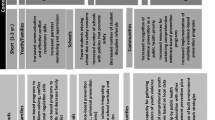Abstract
Black adolescents are exposed disproportionately to community violence. The high rate of community violence victimization among black males is an urgent issue, and the paucity of evidence-based programs/services to meet their needs is unsatisfactory. Community violence victimization can have a lifelong impact on a young person’s functioning (World Health Organization 2016; Guerra and Dierkhising 2011). A concerted effort is needed to link black male survivors of community violence to services that can help them begin to heal and protect them from the risks of victimization. This study used two established evidence based registries to describe the programs and practices that have been rated effective for black males who are survivors of community violence victimization. Results highlight the critical need for the development and evaluation of programs and practices that meet the specific needs of black males.
Similar content being viewed by others
References
Burke, L. A., Neimeyer, R. A., & McDevitt-Murphy, E. (2010). African American homicide bereavement: Aspects of social support that predict complicated grief, PTSD, and depression. Omega: Journal of Death and Dying, 61(1), 1–24. doi:10.2190/OM.61.1.a.
Busby, D. R., Lambert, S. F., & Ialongo, N. S. (2013). Psychological symptoms linking exposure to community violence and academic functioning in African American adolescents. Journal of Youth and Adolescence, 42, 250–262. doi:10.1007/s10964-012-9895-z.
Centers for Disease Control and Prevention. (2012). Youth violence: Facts at a glance. Available from https://www.cdc.gov/violenceprevention/pdf/yv-datasheet-a.pdf.
Frey, W. H. (2014). Diversity explosion: How new racial demographics are remaking America. Washington, DC: Brookings Institution Press.
Gorman-Smith, D., & Tolan, P. (1998). The role of exposure to community violence and developmental problems among innercity youth. Development and Psychopathology, 10(1), 101–116. doi:10.1017/S0954579498001539.
Guerra, N. G., & Dierkhising, C. B. (2011). The effects of community violence on child development. In R. E. Tremblay (Ed.), Social violence section: Encyclopedia of early child development [online]. Montreal: Centre of Excellence for Early Child Development. Retrieved from http://www.child-encyclopedia.com/sites/default/files/textes-experts/en/907/the-effects-of-community-violence-on-child-development.pdf.
Kwan, R. O., Cureton, E. L., Dozier, K. C., & Victorino, G. P. (2011). Gender differences among recidivist trauma patients. Journal of Surgical Research, 165(1), 25–29. doi:10.1016/j.jss.2010.05.060.
Langton, L., & Truman, J. (2014). Special Report. Socio-emotional impact of violent crime. (NCJ 247076). Washington, DC: United States Department of Justice, Office of Justice Programs, Bureau of Justice Statistics.
Laurie, A., & Neimeyer, R. A. (2008). African Americans in bereavement: Grief as a function of ethnicity. Omega: Journal of Death and Dying, 57(2), 173–193. doi:10.2190/OM.57.2.d.
McDevitt-Murphy, M. E., Neimeyer, R. A., Burke, L. A., Williams, J. L., & Lawson, K. (2012, May). The toll of traumatic loss in African Americans bereaved by homicide. Psychological Trauma, 4(3), 303–311. doi:10.1037/a0024911.
Perry, B. D. (1997). Incubated in terror: Neurodevelopmental factors in the ‘cycle of violence’. In J. Osofsky (Ed.), Children, youth, and violence: The search for solutions (pp. 124–148). New York: Guilford Press.
Salloum, A., & Overstreet, S. (2012). Grief and trauma intervention for children after disaster: Exploring coping skills versus trauma narration. Behaviour Research and Therapy, 50(3), 169–179. doi:10.1016/j.brat.2012.01.001.
Sheidow, A. J., Gorman-Smith, D., Tolan, P. H., & Henry, D. B. (2001). Family and community characteristics: Risk factors for violence exposure in inner-city youth. Journal of Community Psychology, 29(3), 345–360. doi:10.1002/jcop.1021.
Sims, B., Yost, B., & Abbott, C. (2005). Use and nonuse of victim service programs: Implications from a statewide survey of crime victims. Criminology and Public Policy, 4, 361–384.
Smith, J. R. (2015). (2015). Unequal burdens of loss: Examining the frequency and timing of homicide deaths experienced by young black men across the life course. American Journal of Public Health., 105(Suppl 3), S483–S490. doi:10.2105/AJPH.2014.302535.
Thomas, A., Carey, D., Prewitt, K., Romero, E., Richards, M., & Velsor-Friedrich, B. (2012). African-American youth and exposure to community violence: Supporting change from the inside. Journal for Social Action in Counseling and Psychology, 4(1), 54–68.
U.S. Department of Justice. (2013). Vision 21: Transforming victim services—Final report. Washington, DC: U.S. Department of Justice, Office of Justice Programs, Office for Victims of Crime.
Vogel, D. L., Heimerdinger-Edwards, S. R., Hammer, J. H., & Hubbard, A. (2011). "boys don't cry": Examination of the links between endorsement of masculine norms, self-stigma, and help-seeking attitudes for men from diverse backgrounds. Journal of Counseling Psychology, 58(3), 368–382.
World Health Organization. (2016). Youth violence fact sheet. Retrieved September 2, 2016, from http://www.who.int/mediacentre/factsheets/fs356/en/.
Acknowledgement
The author has received a research grant from the National Institute of Justice and is currently the PI on the NIJ funded Evaluation of the Supporting Male Survivors of Violence Demonstration Initiative. Grant # 2015-VF-GX-K101.
Author information
Authors and Affiliations
Corresponding author
Rights and permissions
About this article
Cite this article
Hawkins, S. Programs and Services for Black Male Survivors of Community Violence: What’s Effective?. Journ Child Adol Trauma 10, 139–145 (2017). https://doi.org/10.1007/s40653-017-0147-y
Published:
Issue Date:
DOI: https://doi.org/10.1007/s40653-017-0147-y




